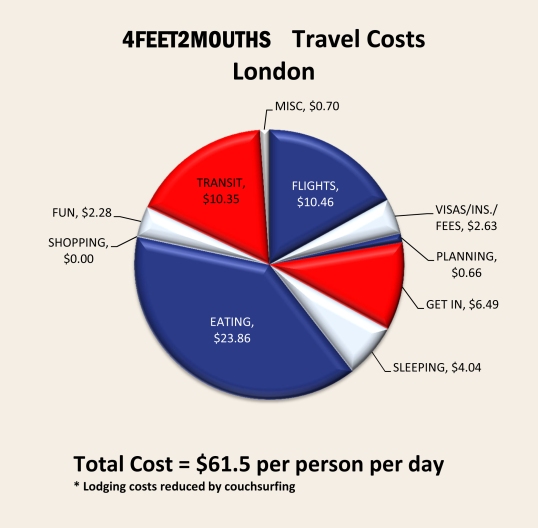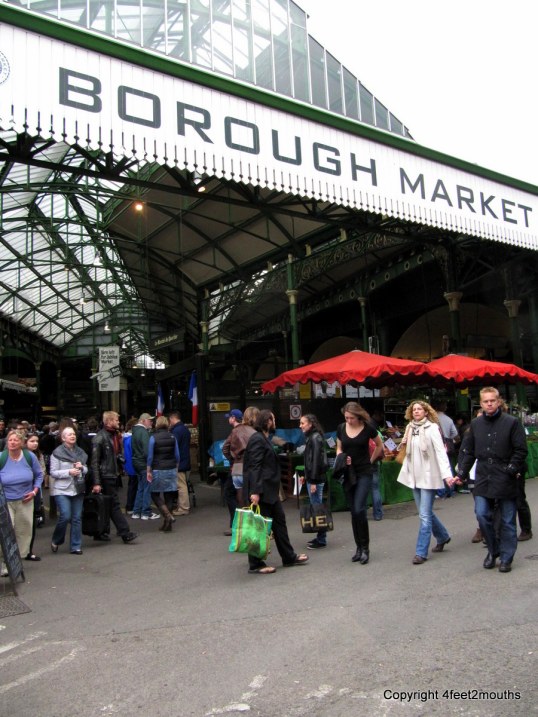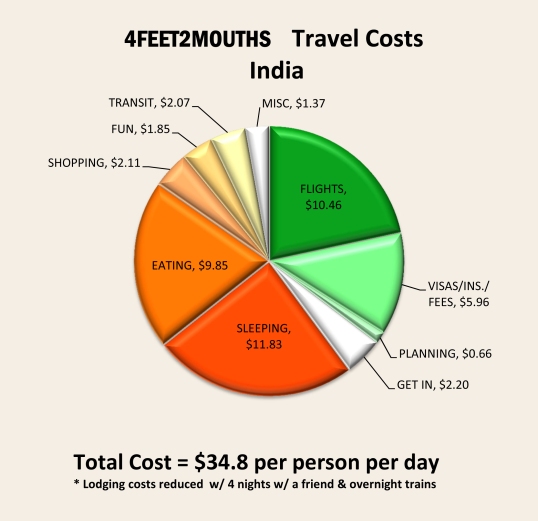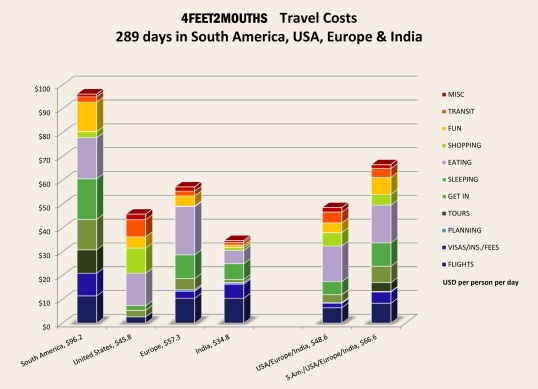Costs of Travel #3: Highs and Lows in Europe & India (by Carmen)
In August of 2012 Nathan and I were excitedly preparing for the Big Trip – our around the world adventure that would take us eastward towards Europe, Asia and all the way back to California. Based on our travels earlier in 2012 we felt ready – we knew what to pack and how to plan and, importantly, how to budget. South America had taught us valuable lessons on blowing a budget and we managed to find a better balance in our US travels.
But we were about to be tested. Everyone loves Europe’s history, culture, and food but invariably people always need to mention the expense. This is especially true of our very first destination – London. And they’re right. London is expensive for the visitor. I will note that living there is a different story since cooking your meals offers huge costs savings (more than in the States) and my former employer covered all transit costs for me and Nathan (a dream deal). But this time we were tourists and we needed to cut costs somewhere. Enter couchsurfing, round 2. Our first experience couchsurfing, which took place in Nebraska, was unique and resulted in us borrowing a tent and setting up in a local campground. This time around, it was much more of a cultural exchange. Our host, a Malaysian native studying law, cooked us some fried rice. We later cooked him a feast with supplies from the nearest polski sklep (Polish grocery shop). Couchsurfing saved us at least $50 a night – and that’s the price for 2 beds in a 12 bed dorm room! For a private room, forget it. Instead, we spent our money on the city’s excellent restaurants and riding my favorite transit option, the tube. And, as always, London has some of the best museums in the world and they’re free! Hence, the low entertainment costs.
After London, we began one of our greatest adventures yet – the Camino de Santiago. Plenty of literature can be found online and in books on the average costs of the Camino and we were right on target at $32.42 per day (not including costs to get to Spain and back). Obviously, the biggest budget item is food – necessary to fuel your body to walk 8 hours in a day. In this chart, I love how our transit costs are so low. This is because for an entire month I only moved by the power of my own feet. No buses, trains, bikes or cars. This $0.46 represents a day trip we took to La Coruna at the end of our trip, as we spent a few days in Santiago. Overall, the Camino is a great option for learning about Spanish culture on a serious budget.
During the Camino we became used to spending very little. So by the time we got to Madrid, we were ready to splurge! We joined the crowds at hip bars and new-age tapas joints. We ordered an enormous pan of paella topped off with a jug of sangria. We stayed in a private room in a well-located hostel. We still saved by timing our museum visits for free entry and walking around instead of taking transit or taxis. But in the end the Spanish capitol became our most expensive stop on the Big Trip.
Everyone knows Greece has been one of the hardest hit by the recession. So this must mean low prices, right? Well, kind of. Museums have their entry fees and hotels were not cheap. So we did our best to couchsurf, which led to more awesome experiences and new friendships. Where we did stay in hotels, we used the fact that it was the shoulder season (October) to our advantage and bargained with hotel owners on the islands. This worked out to have some significant savings for us. You can’t really bargain at restaurants, though, so our food costs ended up being the biggest chunk of the pie. But at least our cheap gyro meals kept this cost lower than it could have been.
Turkey proved to be a similar cost to Greece, though the breakdown is quite different. Our eating costs reduced significantly even though we were still eating in casual restaurants. But our couchsurfing efforts didn’t pan out therefore we ended up in hostels. I really loved our Selcuk hostel, though, so in the end it all worked out. Compared to the rest of Europe, Turkey really offers great sights and food for relatively low cost.
Overall, Europe was not a budget breaker at all. It can be, as our splurge in Madrid showed. And without the couchsurfing our costs would have gone up. But I feel that we had really found our balance in spending where it meant the most for us (more simply, food).

Delicious idli and gunta ponganalu breakfast from Hampi, India. I’m pretty sure this cost about $0.60 or less with our morning chai.
And now for something completely different. India was not only a culture shock to the system, it was shockingly cheap. Especially all the gloriously delicious food. We mostly ate at street food stalls and casual restaurants, but everywhere we went we just shook our heads at the low prices. Food has no cost premium, but land does. Fit a billion people in a country a third the size of the continental US and you better believe it’s crowded. Therefore, hostels were relatively expensive at $25 a night for a private room in the bigger cities. Of course, in the bigger picture this is cheap so go ahead and live like a king in India. For me, the budget in India was so low that it inspired my personal back-up plan. If at some point in my life I need to take a break, some time to step back and breathe, I’m headed to India where I could probably spend a year living comfortably and eating well for $10K.
So I’ve taken you through the highs and lows of our Big Trip budget. Europe was our high, but by making key cuts in our sleeping and eating costs we were able to keep our budget in check. In India it’s not expensive to splash out but we still decided to keep budget in mind and stayed at low-cost hotels and ate plenty of street food. We were striving to keep our overall travel budget for the year at $50 per day, which means we were going to have to make-up for our blown South America budget. So far we were still around $67 per day. Did we succeed in bringing it down? Our next post on costs through the rest of Asia will reveal all!






















































































































































